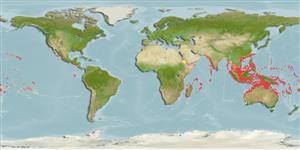Common names from other countries
>
Acanthuriformes (Surgeonfishes) >
Acanthuridae (Surgeonfishes, tangs, unicornfishes) > Acanthurinae
Etymology: Acanthurus: Greek, akantha = thorn + Greek, oura = tail (Ref. 45335).
More on author: Linnaeus.
Issue
Planes and Fauvelot (2002) studied Acanthurus triostegus over its vast range and published in the journal Evolution and they did not recognize Acanthurus triostegus sandvicensis as a species. FishBase follows Randall, 1956 with A. sandvicensis as a subspecies (synonym) of A. triostegus.
Environment: milieu / climate zone / depth range / distribution range
Ecología
marino asociado a arrecife; rango de profundidad 0 - 90 m (Ref. 9710), usually 0 - 90 m (Ref. 27115). Tropical; 26°N - 36°S, 25°E - 85°W (Ref. 57245)
Indo-Pacific: throughout the region except for the seas around the Arabian Peninsula. Eastern Pacific: lower Gulf of California to Panama, including the Revillagigedo, Cocos, Clipperton, and Galapagos islands.
Length at first maturity / Tamaño / Peso / Age
Maturity: Lm 8.8 range ? - ? cm
Max length : 27.0 cm TL macho / no sexado; (Ref. 3145); common length : 17.0 cm TL macho / no sexado; (Ref. 9267)
Espinas dorsales (total) : 9; Radios blandos dorsales (total) : 22 - 26; Espinas anales: 3; Radios blandos anales: 19 - 22. Body olivaceous gray, with 4 vertical stripes (1 stripe on head across the yellow eye; 1 on caudal peduncle); shading to white ventrally, often with a sharp line of demarcation. Sharp, forward-pointing, erectile spine on each side of caudal peduncle which folds down into a groove. Scales minute. Teeth with denticulations on sides and top. Gill rakers 18-22 in anterior row, 19-24 in posterior row.
Adults occur in lagoon and seaward reefs with hard substrate; young abundant in tide pools (Ref. 3145, 48637). Benthopelagic (Ref. 58302). Often feeding near freshwater run-offs where certain algae grow on rocks that are grazed (Ref. 48637). Occasionally form schools; feed on filamentous algae in large aggregations. During spawning, clouds of eggs and sperm are preyed upon by eagle rays which are often present during spawning. Form spawning aggregations (Ref. 27825). Size of metamorphosis from post-larva stage to juvenile is 3.2 cm (Ref. 9267). Utilized as a food fish (Ref. 7364). Minimum depth reported taken from Ref. 27115.
Form spawning aggregations (Ref. 27825).
Randall, J.E., 1956. A revision of the surgeonfish genus Acanthurus. Pac. Sci. 10(2):159-235. (Ref. 1920)
IUCN Red List Status (Ref. 130435)
CITES (Ref. 128078)
Not Evaluated
Threat to humans
Reports of ciguatera poisoning (Ref. 4690)
Human uses
Warning: mysqli::__construct(): (08004/1040): Too many connections in /var/www/html/includes/func_getlabel.php on line 46
Can't connect to MySQL database (fbapp). Errorcode: Too many connections
